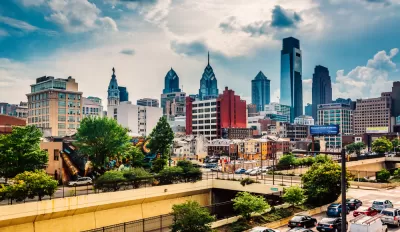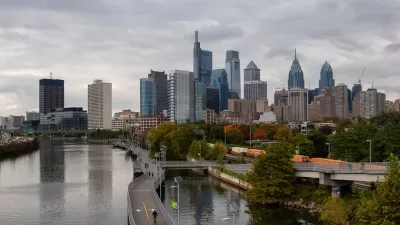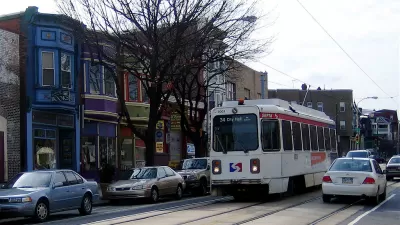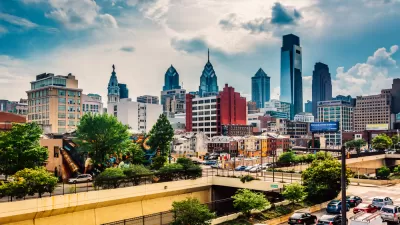The High Line is a famous example of urban revitalization, but a useful commuter path it is not. Can a similar proposal in Philadelphia offer the benefits of beautification and mobility?

Malcom Burnley revisits the idea of a linear park like the one proposed for the Reading Viaduct in Philadelphia as a benefit to the mobility of the city, not just another example of urban beautification similar to the example set by the High Line in New York City.
Burnley tours the proposed route with Michael Garden, boardmember with the Friends of the Rail Park, the driving force behind the proposed project. Before discussing its potential mobility benefits of the park, Brunley provides this summary of the long-term plans for the park:
In Phase 1, the elevated rail line would be repurposed, much like the High Line. In Phase 2, a 1.75-mile stretch of underground tunnels and dug-out space known as the City Branch (or, colloquially in transit circles, as “The Cut”) would be redone into a green corridor with paved throughways that might rival the cool factor of the Schuylkill Banks.
Distinguishing the Viaduct Rail Park proposal from the often-clogged High Line, "Garden envisions both the above-ground and below-ground portions of project as having ample room for bike lanes, running/pedestrian lanes, recreational space and even retail kiosks with coffee (and maybe some of those bougie popsicles)."
Burnley's conclusion after considering Garden's points:
I’d argue that the proposed rail park would not be transformative in the way that, say, stripping parking minimums from the zoning code or creating rapid transit on Roosevelt Boulevard would be. In that sense, maybe it’s a luxury transportation improvement. Nonetheless, it’s one that the city deserves.
The article follows an earlier article by Brunley listing 20 "smart transportation ideas" underway in Philadelphia. At the time, he left the Reading Viaduct off the list. An October study by the Delaware Valley Regional Planning Commission [pdf] concluded the potentially building a bus-only route along the path of the viaduct would be too expensive.
FULL STORY: Reading Viaduct Park Would Make Getting Around Philly Easier

Americans May Be Stuck — But Why?
Americans are moving a lot less than they once did, and that is a problem. While Yoni Applebaum, in his highly-publicized article Stuck, gets the reasons badly wrong, it's still important to ask: why are we moving so much less than before?

Using Old Oil and Gas Wells for Green Energy Storage
Penn State researchers have found that repurposing abandoned oil and gas wells for geothermal-assisted compressed-air energy storage can boost efficiency, reduce environmental risks, and support clean energy and job transitions.

Placekeeping: Setting a New Precedent for City Planners
How a preservation-based approach to redevelopment and urban design can prevent displacement and honor legacy communities.

San Francisco’s Muni Ridership Grew in 2024
The system saw its highest ridership since before the Covid-19 pandemic, but faces a severe budget shortage in the coming year.

Colorado Lawmakers Move to Protect BRT Funding
In the face of potential federal funding cuts, CDOT leaders reasserted their commitment to planned bus rapid transit projects.

Safe Streets Funding in Jeopardy
The Trump administration is specifically targeting bike infrastructure and other road safety projects in its funding cuts.
Urban Design for Planners 1: Software Tools
This six-course series explores essential urban design concepts using open source software and equips planners with the tools they need to participate fully in the urban design process.
Planning for Universal Design
Learn the tools for implementing Universal Design in planning regulations.
Heyer Gruel & Associates PA
City of Moreno Valley
Institute for Housing and Urban Development Studies (IHS)
City of Grandview
Harvard GSD Executive Education
Salt Lake City
NYU Wagner Graduate School of Public Service
City of Cambridge, Maryland





























